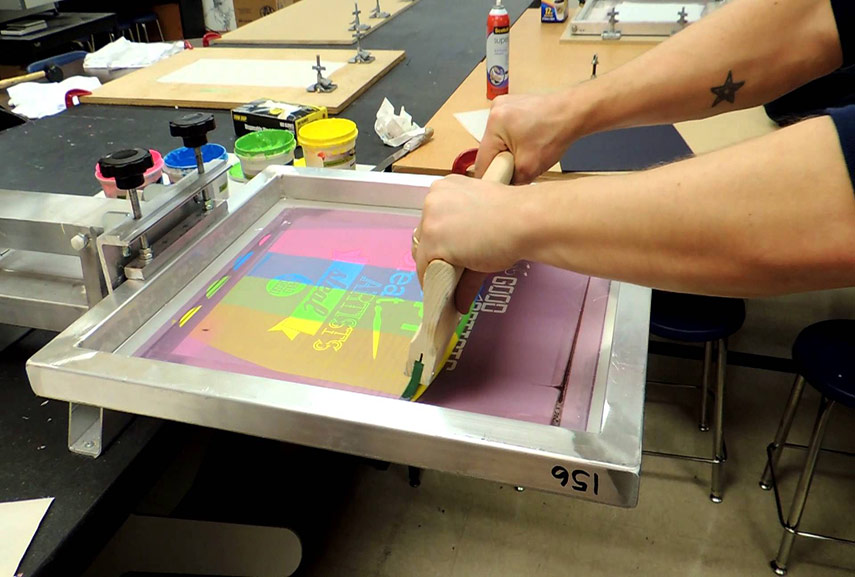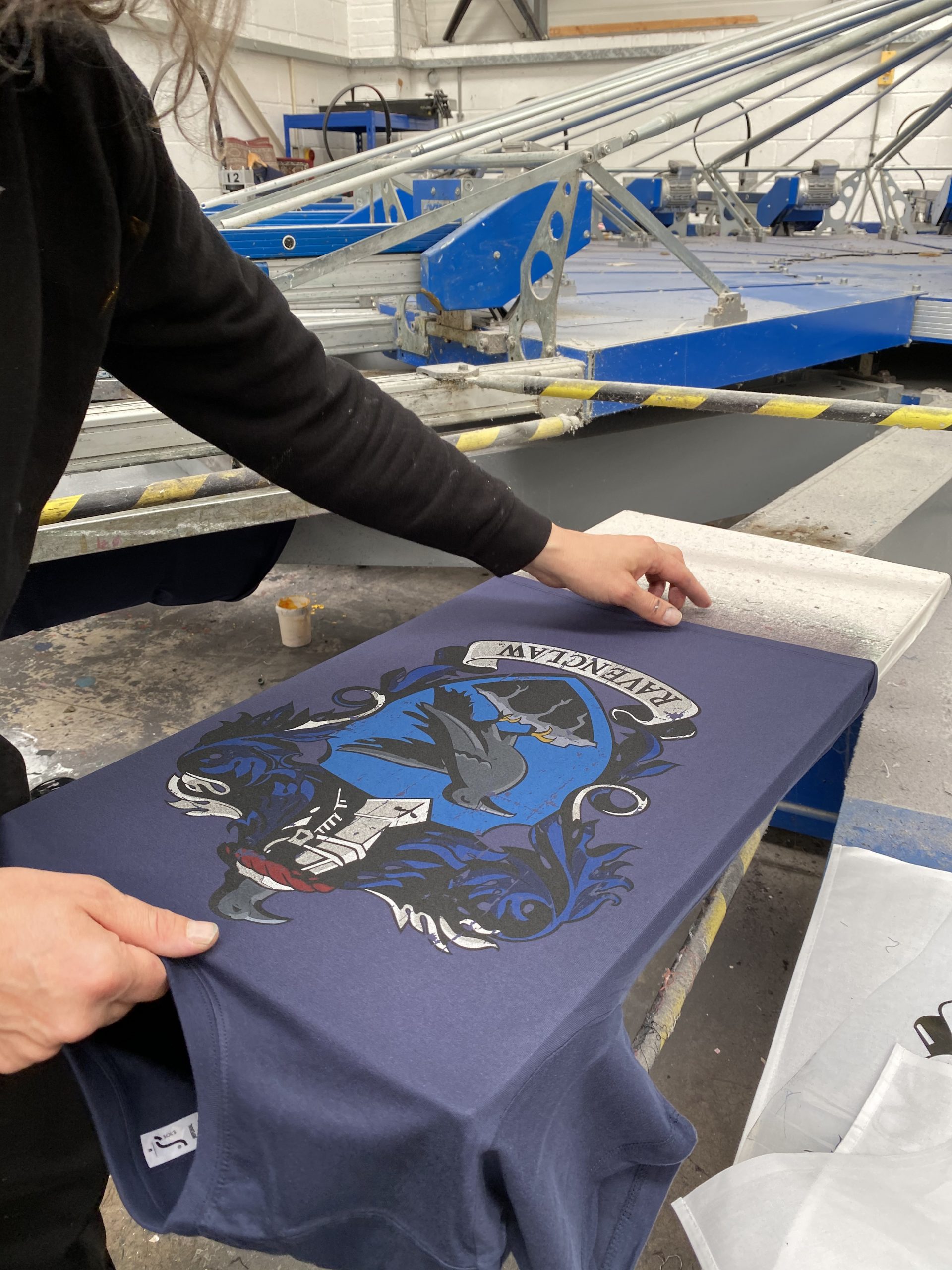The Crucial Overview to Recognizing Screen Printing and Its Versatile Makes use of
Screen printing has a rich history that goes back to old times, evolving into an innovative method made use of throughout different markets today. This overview checks out the intricacies of the screen printing process, outlining its applications in home, advertising and marketing, and fashion décor - 10:9 Design Screen Printing Texas. Comprehending these principles can open up creative capacity for both artistic and industrial tasks. The following areas will disclose vital ideas and techniques to improve one's screen printing ventures
The History of Screen Printing
Screen printing has origins that trace back centuries, its development reflects the technical and imaginative advancements of various cultures. Coming from old China, the technique was originally made use of for enhancing fabrics and later spread to Japan, where it came to be indispensable to Ukiyo-e woodblock printing. The technique moved to Europe in the 18th century, where it gained popularity among craftsmens and commercial printers. The creation of image emulsion in the 20th century transformed screen printing, permitting more detailed designs and greater performance. Artists like Andy Warhol further moved its popularity, using the tool to produce iconic works that combined commercialism and art. By the late 20th century, screen printing had actually developed itself as a functional strategy, utilized in vogue, advertising, and art. Today, it remains to progress, incorporating electronic modern technology and broadening its applications across various sectors.
The Screen Printing Refine Explained
Screen printing changes artistic visions right into tangible layouts via a collection of precise steps. An image is developed and after that transferred onto a screen, commonly made of great mesh material stretched over a framework. A light-sensitive emulsion is related to the screen, which is exposed to light, solidifying in areas not covered by the picture. After cleaning out the unhardened emulsion, a stencil is created.
Next off, the screen is put over the substrate, whether it be fabric, paper, or one more product. Ink is after that pushed via the open areas of the pattern using a squeegee, transferring the layout onto the substratum listed below. This process can be repeated for multiple shades, needing separate displays for each hue. The printed product is healed utilizing warmth to guarantee the ink adheres appropriately, resulting in a long lasting, vivid design ready for usage.
Sorts Of Screen Printing Techniques

Additionally, specialty strategies, such as discharge screen printing, get rid of dye from the fabric to create softer prints, while aluminum foil screen printing applies metal aluminum foil to accomplish a shiny coating (10:9 Design Company). Each method supplies distinctive attributes, catering to different creative needs and production scales, eventually expanding the possibilities within the screen printing domain name
Applications of Screen Printing in Numerous Industries

Furthermore, the signs and advertising and marketing sectors utilize screen printing for developing distinctive display screens and banners. This approach permits for strong colors and complex layouts that record attention. In electronic devices, screen printing is utilized for applying conductive inks to circuit boards, essential for component links. The home style industry welcomes screen printing to read more create unique designs on textiles and wall surface art. Generally, screen printing functions as an essential tool across diverse fields, enhancing products with personalized and aesthetically appealing graphics.
Tips for Effective Screen Printing Projects
While carrying out a screen printing task, mindful focus to information can significantly enhance the last outcome. Selecting top quality materials is important; this consists of the screen, inks, and substrates. Utilizing suitable mesh matters can impact ink deposition and information resolution. Preparation is equally vital; comprehensive cleansing of screens and proper exposure times guarantee crisp prints.
Next off, accurate enrollment is crucial for multi-color prints. Using positioning tools can help attain exact layering. In addition, testing prints on scrap materials before manufacturing helps identify prospective issues without wasting resources.

Frequently Asked Concerns
What Materials Are Best for Screen Printing on Fabric?
Cotton and polyester blends are excellent for screen printing on textile as a result of their durability and ink absorption. Furthermore, specialty textiles like silk or canvas can produce unique textures and surfaces, boosting the general layout top quality.
Just how Do I Tidy and Maintain Screen Printing Devices?
To preserve and clean screen printing equipment, one should routinely clean screens with appropriate solvents, evaluate mops for wear, lube relocating parts, and shop all items in a completely dry, dust-free atmosphere to prolong their lifespan.
What Are the Ecological Influences of Screen Printing?
Screen printing can have considerable ecological impacts, including chemical waste from solvents and inks, water usage during cleansing procedures, and energy intake. Lasting techniques and environment-friendly products are necessary for reducing these negative impacts.
Can Screen Printing Be Done at Home Properly?
Screen printing can be properly done at home with the appropriate products and strategies. Hobbyists can create high quality prints, though success relies on their ability level, equipment, and understanding of the process included.
What Are the Expenses Related To Starting a Display Printing Business?

Starting a screen printing organization involves prices for equipment, materials, and workspace. Initial costs commonly range from a couple of hundred to a number of thousand dollars, depending on the scale, high quality of machinery, and desired production capability.
Screen printing has an abundant background that dates back to ancient times, advancing right into an innovative strategy used across different sectors today. An additional technique, rotary screen printing, uses round screens, assisting in continuous printing on fabric rolls, consequently boosting effectiveness for large-scale productions. Furthermore, specialty techniques, such as discharge screen printing, remove dye from the material to produce softer prints, while aluminum foil screen printing uses metallic foil to attain a shiny finish. In the fashion sector, screen printing is extensively used to develop dynamic layouts on apparel, enabling brand names to showcase their distinct styles. Cotton and polyester blends are optimal for screen printing on material due to their longevity and ink absorption.